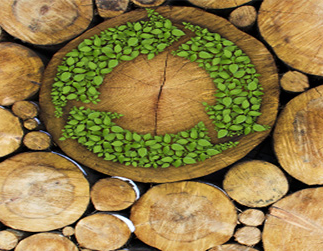Fuel Production from Biomass Using Sunlight
Published on by Marina A, Previously Key Account and Content Manager at AquaSPE AG in Technology
Scientists from University of Cambridge created a way of using sunlight to make clean hydrogen, sustainable and inexpensive fuel, from biomass.
 Biomass is a renewable energy source from organic materials.
Biomass is a renewable energy source from organic materials.
It usually refers to plant-based materials leftovers from food and is often called lignocellulosic biomass.
Lignocellulose is composed of carbohydrate polymers containing sugar monomers which are tightly bound to the aromatic polymer (lignin).
Converting biomass to fuel has until now been achieved only by combustion to produce heat – directly or indirectly after it has been converted to biofuel.
Dr Moritz Kuehnel, from the Department of Chemistry at the University of Cambridge says: "Lignocellulose is nature's equivalent to armoured concrete. It consists of strong, highly crystalline cellulose fibres, that are interwoven with lignin and hemicellulose which act as a glue. This rigid structure has evolved to give plants and trees mechanical stability and protect them from degradation, and makes chemical utilisation of lignocellulose so challenging."
The new method of using sunlight to create fuel uses a simple photocatalytic conversion process.
Photocatalysis is the acceleration of a photoreaction in the presence of a catalyst.
In this method, catalytic nanoparticles are added to alkaline water with suspended biomass particles. The water is then lit in the lab. This light, similar to sunlight, is absorbed by nanoparticles and by complex chemical reactions – rearranging the atoms in water and biomass to form hydrogen fuel and organic chemicals - biomass is turned into gaseous hydrogen.
Hydrogen does not contain fuel-cell inhibitors and can be used to generate power.
Dr David Wakerley, also of the Department of Chemistry, says: "There's a lot of chemical energy stored in raw biomass, but it's unrefined, so you can't expect it to work in complicated machinery, such as a car engine. Our system is able to convert the long, messy structures that make up biomass into hydrogen gas, which is much more useful. We have specifically designed a combination of catalyst and solution that allows this transformation to occur using sunlight as a source of energy. With this in place we can simply add organic matter to the system and then, provided it's a sunny day, produce hydrogen fuel."
Different types of biomass, without any processing, were successful in being converted to hydrogen: wood, paper and leaves.
Dr. Erwin Reisner, adds: "Our sunlight-powered technology is exciting as it enables the production of clean hydrogen from unprocessed biomass under ambient conditions. We see it as a new and viable alternative to high temperature gasification and other renewable means of hydrogen production.
Future development can be envisioned at any scale, from small scale devices for off-grid applications to industrial-scale plants, and we are currently exploring a range of potential commercial options."
Dr. Erwin Reisner, head of the Cambridge Christian Doppler Laboratory for Sustainable SynGas Chemistry, adds: "Our sunlight-powered technology is exciting as it enables the production of clean hydrogen from unprocessed biomass under ambient conditions. We see it as a new and viable alternative to high temperature gasification and other renewable means of hydrogen production.
Future development can be envisioned at any scale, from small scale devices for off-grid applications to industrial-scale plants, and we are currently exploring a range of potential commercial options."
Media
Taxonomy
- Photocatalysis
- Catalysts
- Biofuels
- Biofuels
- Energy
- Renewable Energy
- Biomass
- Renewable Energy Technologies
- Renewable Energy
- Renewable Energy Power
- Alternative Fuels
- Photocatalyst